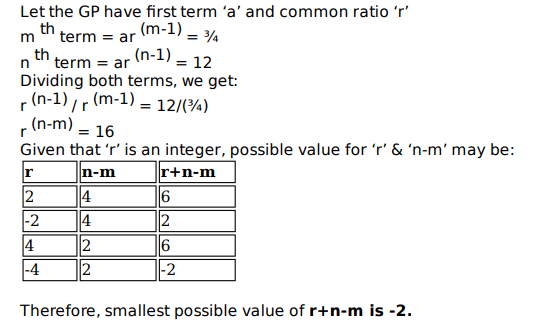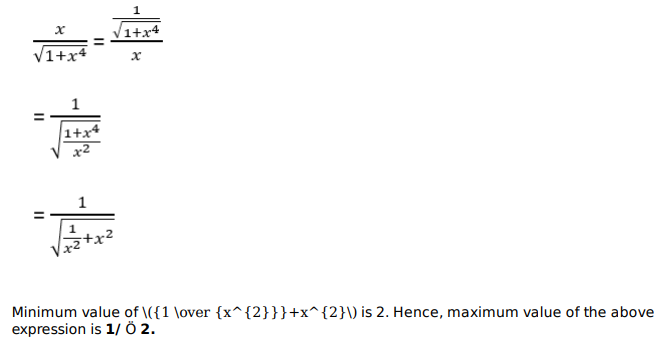Live Updates
• CATKing has launched new chat bot.

• New video on Logs has been released.
495
Learners
asked the doubt

Previous Year Questions
The passage below is accompanied by a set of questions. Choose the best answer to each question.
The claims advanced here may be condensed into two assertions: [first, that visual] culture is what images, acts of seeing, and attendant intellectual, emotional, and perceptual sensibilities do to build, maintain, or transform the worlds in which people live. [And second, that the] study of visual culture is the analysis and interpretation of images and the ways of seeing (or gazes) that configure the agents, practices, conceptualities, and institutions that put images to work. . . .
Accordingly, the study of visual culture should be characterized by several concerns. First, scholars of visual culture need to examine any and all imagery – high and low, art and nonart. . . . They must not restrict themselves to objects of a particular beauty or aesthetic value. Indeed, any kind of imagery may be found to offer up evidence of the visual construction of reality. . . .
Second, the study of visual culture must scrutinize visual practice as much as images themselves, asking what images do when they are put to use. If scholars engaged in this enterprise inquire what makes an image beautiful or why this image or that constitutes a masterpiece or a work of genius, they should do so with the purpose of investigating an artist’s or a work’s contribution to the experience of beauty, taste, value, or genius. No amount of social analysis can account fully for the existence of Michelangelo or Leonardo. They were unique creators of images that changed the way their contemporaries thought and felt and have continued to shape the history of art, artists, museums, feeling, and aesthetic value. But study of the critical, artistic, and popular reception of works by such artists as Michelangelo and Leonardo can shed important light on the meaning of these artists and their works for many different people. And the history of meaning-making has a great deal to do with how scholars as well as lay audiences today understand these artists and their achievements.
Third, scholars studying visual culture might properly focus their interpretative work on lifeworlds by examining images, practices, visual technologies, taste, and artistic style as constitutive of social relations. The task is to understand how artifacts contribute to the construction of a world. . . . Important methodological implications follow: ethnography and reception studies become productive forms of gathering information, since these move beyond the image as a closed and fixed meaning-event. . . .
Fourth, scholars may learn a great deal when they scrutinize the constituents of vision, that is, the structures of perception as a physiological process as well as the epistemological frameworks informing a system of visual representation. Vision is a socially and a biologically constructed operation, depending on the design of the human body and how it engages the interpretive devices developed by a culture in order to see intelligibly. . . . Seeing . . . operates on the foundation of covenants with images that establish the conditions for meaningful visual experience.
Finally, the scholar of visual culture seeks to regard images as evidence for explanation, not as epiphenomena.
Which one of the following best describes the word “epiphenomena” in the last sentence of the passage?
Video Explanation

Explanatory Answer
Note the context in which the word is used: "the scholar of visual culture seeks to regard images as evidence for explanation, not as epiphenomena". Substituting each of the answer options instead of 'epiphenomena' in this sentence, we see that only option B makes sense. Epiphenomena are phenomena supplemental to the evidence.
All of the following statements may be considered valid inferences from the passage, EXCEPT:
Video Explanation

Explanatory Answer
The passage does not mention 'institutional structures' or talk about these being essential to the study of visual culture.
From the line, "...task is to understand how artifacts contribute to the construction of a world", we understand A is true. C is true, based on the line "..scholars may learn a great deal when they scrutinize the constituents of vision, that is, the structures of perception as a physiological process as well as the epistemological frameworks informing a system of visual representation". D is also true, based on the first paragraph.
“No amount of social analysis can account fully for the existence of Michelangelo or Leonardo.” In light of the passage, which one of the following interpretations of this sentence is the most accurate?
Video Explanation

Explanatory Answer
Note the line that follows the given line in the passage: "They were unique creators of images that changed the way their contemporaries thought and felt and have continued to shape the history of art, artists, museums, feeling, and aesthetic value."In other words, social analysis cannot fully account for the existence of Michelangelo or Leonardo as it cannot explain their genius.
“Seeing . . . operates on the foundation of covenants with images that establish the conditions for meaningful visual experience.” In light of the passage, which one of the following statements best conveys the meaning of this sentence?
Video Explanation

Explanatory Answer
The given sentence implies sight works on the basis of covenants with images we see. These help establish a meaningful visual experience. Option A captures the meaning of the line best.
Which set of keywords below most closely captures the arguments of the passage?
Video Explanation

Explanatory Answer
All words in option C relate to key ideas in the passage.
Option A mentions 'lay audience' which is not a key idea. In the same way, options B and D mention 'Michelangelo and Leonardo' and 'work of genius' respectively. The passage mentions Michelangelo and Leonardo but that is to make a point about meaning-making.
The passage below is accompanied by a set of questions. Choose the best answer to each question.
174 incidents of piracy were reported to the International Maritime Bureau last year, with Somali pirates responsible for only three. The rest ranged from the discreet theft of coils of rope in the Yellow Sea to the notoriously ferocious Nigerian gunmen attacking and hijacking oil tankers in the Gulf of Guinea, as well as armed robbery off Singapore and the Venezuelan coast and kidnapping in the Sundarbans in the Bay of Bengal. For [Dr. Peter] Lehr, an expert on modern-day piracy, the phenomenon’s history should be a source of instruction rather than entertainment, piracy past offering lessons for piracy present. . . .
But . . . where does piracy begin or end? According to St Augustine, a corsair captain once told Alexander the Great that in the forceful acquisition of power and wealth at sea, the difference between an emperor and a pirate was simply one of scale. By this logic, European empire-builders were the most successful pirates of all time. A more eclectic history might have included the conquistadors, Vasco da Gama and the East India Company. But Lehr sticks to the disorganised small fry, making comparisons with the renegades of today possible.
The main motive for piracy has always been a combination of need and greed. Why toil away as a starving peasant in the 16th century when a successful pirate made up to £4,000 on each raid? Anyone could turn to freebooting if the rewards were worth the risk . . . .
Increased globalisation has done more to encourage piracy than suppress it. European colonialism weakened delicate balances of power, leading to an influx of opportunists on the high seas. A rise in global shipping has meant rich pickings for freebooters. Lehr writes: “It quickly becomes clear that in those parts of the world that have not profited from globalisation and modernisation, and where abject poverty and the daily struggle for survival are still a reality, the root causes of piracy are still the same as they were a couple of hundred years ago.” . . .
Modern pirate prevention has failed. After the French yacht Le Gonant was ransomed for $2 million in 2008, opportunists from all over Somalia flocked to the coast for a piece of the action. . . . A consistent rule, even today, is there are never enough warships to patrol pirate-infested waters. Such ships are costly and only solve the problem temporarily; Somali piracy is bound to return as soon as the warships are withdrawn. Robot shipping, eliminating hostages, has been proposed as a possible solution; but as Lehr points out, this will only make pirates switch their targets to smaller carriers unable to afford the technology.
His advice isn’t new. Proposals to end illegal fishing are often advanced but they are difficult to enforce. Investment in local welfare put a halt to Malaysian piracy in the 1970s, but was dependent on money somehow filtering through a corrupt bureaucracy to the poor on the periphery. Diplomatic initiatives against piracy are plagued by mutual distrust: the Russians execute pirates, while the EU and US are reluctant to capture them for fear they’ll claim asylum.
“A more eclectic history might have included the conquistadors, Vasco da Gama and the East India Company. But Lehr sticks to the disorganised small fry . . .” From this statement we can infer that the author believes that:
Video Explanation

Explanatory Answer
Note the context in which the given statement is made. In paragraph 2, the author asks where piracy begins or ends and says "European empire-builders were the most successful pirates of all time". So, the author believes
We can deduce that the author believes that piracy can best be controlled in the long run:
Video Explanation

Explanatory Answer
According to the passage, the "root causes" of piracy are abject poverty and the daily struggle for survival (paragraph 4). The author also explains in the last two paragraphs that international cooperation in enforcing strict deterrents, investments in local welfare and using technology solutions like robot shipping have failed.
“Why toil away as a starving peasant in the 16th century when a successful pirate made up to £4,000 on each raid?” In this sentence, the author’s tone can best be described as being:
Video Explanation

Explanatory Answer
Clearly, the author's tone here is sardonic/ironic, highlighting how much more rewarding it was to engage in piracy than toiling away as a peasant in medieval times.
The author ascribes the rise in piracy today to all of the following factors EXCEPT:
Video Explanation

Explanatory Answer
The passage states that there are never enough warships to patrol pirate-infested waters, but this does not imply that the surveillance at the high seas is declining, just that the scale of the problem is large. All other reasons for rise in piracy today are mentioned in the lines "Increased globalisation has done more to encourage piracy than suppress it. European colonialism weakened delicate balances of power, leading to an influx of opportunists on the high seas."
The passage below is accompanied by a set of questions. Choose the best answer to each question.
Aggression is any behavior that is directed toward injuring, harming, or inflicting pain on another living being or group of beings. Generally, the victim(s) of aggression must wish to avoid such behavior in order for it to be considered true aggression. Aggression is also categorized according to its ultimate intent. Hostile aggression is an aggressive act that results from anger, and is intended to inflict pain or injury because of that anger. Instrumental aggression is an aggressive act that is regarded as a means to an end other than pain or injury. For example, an enemy combatant may be subjected to torture in order to extract useful intelligence, though those inflicting the torture may have no real feelings of anger or animosity toward their subject. The concept of aggression is very broad, and includes many categories of behavior (e.g., verbal aggression, street crime, child abuse, spouse abuse, group conflict, war, etc.). A number of theories and models of aggression have arisen to explain these diverse forms of behavior, and these theories/models tend to be categorized according to their specific focus. The most common system of categorization groups the various approaches to aggression into three separate areas, based upon the three key variables that are present whenever any aggressive act or set of acts is committed. The first variable is the aggressor him/herself. The second is the social situation or circumstance in which the aggressive act(s) occur. The third variable is the target or victim of aggression.
Regarding theories and research on the aggressor, the fundamental focus is on the factors that lead an individual (or group) to commit aggressive acts. At the most basic level, some argue that aggressive urges and actions are the result of inborn, biological factors. Sigmund Freud (1930) proposed that all individuals are born with a death instinct that predisposes us to a variety of aggressive behaviors, including suicide (self directed aggression) and mental illness (possibly due to an unhealthy or unnatural suppression of aggressive urges). Other influential perspectives supporting a biological basis for aggression conclude that humans evolved with an abnormally low neural inhibition of aggressive impulses (in comparison to other species), and that humans possess a powerful instinct for property accumulation and territorialism. It is proposed that this instinct accounts for hostile behaviors ranging from minor street crime to world wars. Hormonal factors also appear to play a significant role in fostering aggressive tendencies. For example, the hormone testosterone has been shown to increase aggressive behaviors when injected into animals. Men and women convicted of violent crimes also possess significantly higher levels of testosterone than men and women convicted of non violent crimes. Numerous studies comparing different age groups, racial/ethnic groups, and cultures also indicate that men, overall, are more likely to engage in a variety of aggressive behaviors (e.g., sexual assault, aggravated assault, etc.) than women. One explanation for higher levels of aggression in men is based on the assumption that, on average, men have higher levels of testosterone than women.
“[A]n enemy combatant may be subjected to torture in order to extract useful intelligence, though those inflicting the torture may have no real feelings of anger or animosity toward their subject.” Which one of the following best explicates the larger point being made by the author here?
Video Explanation

Explanatory Answer
A rather easy question. As the line indicates, torturing an enemy combatant for intelligence may be just a means to an end.
All of the following statements can be seen as logically implied by the arguments of the passage EXCEPT:
Video Explanation

Explanatory Answer
The passage states that an abnormally low neural regulation of aggressive impulses (not testosterone) in humans accounts for hostile behaviours.
Other statements are implied from the line "Sigmund Freud (1930) proposed that all individuals are born with a death instinct that predisposes us to a variety of aggressive behaviors, including suicide (self directed aggression)..."
The author identifies three essential factors according to which theories of aggression are most commonly categorised. Which of the following options is closest to the factors identified by the author?
Video Explanation

Explanatory Answer
The last few lines of the first paragraph have the answer: "The first variable is the aggressor him/herself. The second is the social situation or circumstance in which the aggressive act(s) occur. The third variable is the target or victim of aggression."
The author discusses all of the following arguments in the passage EXCEPT that:
Video Explanation

Explanatory Answer
Only the idea in option A is not mentioned in the passage.
From the first few lines of the passage we know option B is true and from the last few lines line, we know options C and D are true
The four sentences (labelled A, B, C, D) below, when properly sequenced would yield a coherent paragraph. Decide on the proper sequencing of the order of the sentences and key in the sequence of the four numbers as your answer:
A. But the attention of the layman, not surprisingly, has been captured by the atom bomb, although there is at least a chance that it may never be used again.
B. Of all the changes introduced by man into the household of nature, [controlled] large-scale nuclear fission is undoubtedly the most dangerous and most profound.
C. The danger to humanity created by the so-called peaceful uses of atomic energy may, however, be much greater.
D. The resultant ionizing radiation has become the most serious agent of pollution of the environment and the greatest threat to man’s survival on earth.
Video Explanation

Explanatory Answer
B is the best opening sentence. B states that large-scale nuclear fission is dangerous. D explains how so. So, BD is a sequence about the danger posed by large-scale nuclear fission. Statement A adds to BD, explaining that the attention of the layman, however, directed at the atom bomb instead. C talks of a danger that may be much greater: the danger to humanity by so-called "peaceful uses" of atomic energy. So, BDAC is the correct order.
The four sentences (labelled A, B, C, D) below, when properly sequenced would yield a coherent paragraph. Decide on the proper sequencing of the order of the sentences and key in the sequence of the four numbers as your answer:
A. While you might think that you see or are aware of all the changes that happen in your immediate environment, there is simply too much information for your brain to fully process everything.
B. Psychologists use the term ‘change blindness’ to describe this tendency of people to be blind to changes though they are in the immediate environment.
C. It cannot be aware of every single thing that happens in the world around you.
B. Sometimes big shifts happen in front of your eyes and you are not at all aware of these changes.
Video Explanation

Explanatory Answer
Sentence A is the best opening sentence as it explains the tendency being discussed in the paragraph. The pronoun 'it' in C clearly refers to the brain, mentioned in A. So, AC is a link. AC leads on to D. B, which labels the tendency, is the best concluding sentence.
The passage given below is followed by four alternate summaries. Choose the option that best captures the essence of the passage.
With the Treaty of Westphalia, the papacy had been confined to ecclesiastical functions, and the doctrine of sovereign equality reigned. What political theory could then explain the origin and justify the functions of secular political order? In his Leviathan, published in 1651, three years after the Peace of Westphalia, Thomas Hobbes provided such a theory. He imagined a “state of nature” in the past when the absence of authority produced a “war of all against all.” To escape such intolerable insecurity, he theorized, people delivered their rights to a sovereign power in return for the sovereign’s provision of security for all within the state’s border. The sovereign state’s monopoly on power was established as the only way to overcome the perpetual fear of violent death and war.
Video Explanation

Explanatory Answer
Sentence A is the best opening sentence as it explains the tendency being discussed in the paragraph. The pronoun 'it' in C clearly refers to the brain, mentioned in A. So, AC is a link. AC leads on to D. B, which labels the tendency, is the best concluding sentence.
The passage given below is followed by four alternate summaries. Choose the option that best captures the essence of the passage.
All humans make decisions based on one or a combination of two factors. This is either intuition or information. Decisions made through intuition are usually fast, people don’t even think about the problem. It is quite philosophical, meaning that someone who made a decision based on intuition will have difficulty explaining the reasoning behind it. The decision-maker would often utilize her senses in drawing conclusions, which again is based on some experience in the field of study. On the other side of the spectrum, we have decisions made based on information. These decisions are rational — it is based on facts and figures, which unfortunately also means that it can be quite slow. The decision-maker would frequently use reports, analyses, and indicators to form her conclusion. This methodology results in accurate, quantifiable decisions, meaning that a person can clearly explain the rationale behind it.
Video Explanation

Explanatory Answer
The given paragraph compares intuitive decisions to decisions made based on information, in terms of the speed of decision-making and the ability of the decision maker to explain the rationale behind the decision. Option D captures the essence of the paragraph. Options A and C are limited to intuitive decisions and decisions based on information respectively. Option B does not cover the idea of the ability of the decision maker to explain the rationale behind the decision.
The passage given below is followed by four alternate summaries. Choose the option that best captures the essence of the passage.
The rural-urban continuum and the heterogeneity of urban settings pose an obvious challenge to identifying urban areas and measuring urbanization rates in a consistent way within and across countries. An objective methodology for distinguishing between urban and rural areas that is based on one or two metrics with fixed thresholds may not adequately capture the wide diversity of places. A richer combination of criteria would better describe the multifaceted nature of a city’s function and its environment, but the joint interpretation of these criteria may require an element of human judgment.
Video Explanation

Explanatory Answer
The main idea of the paragraph is that, given the rural-urban continuum, in order to identify urban areas and measure urbanization rates in a consistent manner we need not only a richer combination of measurable criteria but also some element of human judgement. Option D captures all key ideas.
Five jumbled up sentences, related to a topic, are given below. Four of them can be put together to form a coherent paragraph. Identify the odd one out and key in the number of the sentence as your answer:
A. You can observe the truth of this in every e-business model ever constructed: monopolise and protect data.
B. Economists and technologists believe that a new kind of capitalism is being created - different from industrial capitalism as was merchant capitalism.
C. In 1962, Kenneth Arrow, the guru of mainstream economics, said that in a free market economy the purpose of inventing things is to create intellectual property rights.
D. There is, alongside the world of monopolised information and surveillance, a different dynamic growing up: information as a social good, incapable of being owned or exploited or priced.
E. Yet information is abundant. Information goods are freely replicable. Once a thing is made, it can be copied and pasted infinitely
Video Explanation

Explanatory Answer
CA is a clear link. C states that the purpose of inventing things is to create intellectual property rights. Sentence A adds to C. Similarly, DE is a link. D talks of a different dynamic: information as a social good, incapable of being owned, expoited or priced. E adds to the point made in D. CADE is a possible sequence. Only option B is slightly different, about a new kind of capitalism being created.
Five jumbled up sentences, related to a topic, are given below. Four of them can be put together to form a coherent paragraph. Identify the odd one out and key in the number of the sentence as your answer:
A. The victim’s trauma after assault rarely gets the attention that we lavish on the moment of damage that divided the survivor from a less encumbered past.
B. One thing we often do with narratives of sexual assault is sort their respective parties into different temporalities: it seems we are interested in perpetrators’ futures and victims’ pasts.
C. One result is that we don’t have much of a vocabulary for what happens in a victim’s life after the painful past has been excavated, even when our shared language gestures toward the future, as the term “survivor” does.
D. Even the most charitable questions asked about the victims seem to focus on the past, in pursuit of understanding or of corroboration of painful details.
E. As more and more stories of sexual assault have been made public in the last two years, the genre of their telling has exploded --- crimes have a tendency to become not just stories but genres.
Video Explanation

Explanatory Answer
EBCA is a sequence: E talks about the new genre of stories of sexual assault. B adds to this, stating that the telling focuses on the perpetrators’ futures and victims’ pasts. C states the result of this: the lack of vocabulary for what happens in the victim's future. Sentence A adds to C.
Option D is about "questions asked about victims", a related but slightly different idea.
The four sentences (labelled A, B, C, D) below, when properly sequenced would yield a coherent paragraph. Decide on the proper sequencing of the order of the sentences and key in the sequence of the four numbers as your answer:
A. It also has four movable auxiliary telescopes 1.8 m in diameter.
B. Completed in 2006, the Very Large Telescope (VLT) has four reflecting telescopes, 8.2 m in diameter that can observe objects 4 billion times weaker than can normally be seen with the naked eye.
C. This configuration enables one to distinguish an astronaut on the Moon.
D. When these are combined with the large telescopes, they produce what is called interferometry: a simulation of the power of a mirror 16 m in diameter and the resolution of a telescope of 200 m.
Video Explanation

Explanatory Answer
Easy question. B is the best opening sentence. Sentence A adds to B, as it describes the telescope. D states the result of combining the telescopes mentioned in B and A with large telescopes, and C concludes the paragraph stating how this configuration helps.
Twenty five coloured beads are to be arranged in a grid comprising of five rows and five columns. Each cell in the grid must contain exactly one bead. Each bead is coloured either Red, Blue or Green.
While arranging the beads along any of the five rows or along any of the five columns, the rules given below are to be followed:
1. Two adjacent beads along the same row or column are always of different colours.
2. There is at least one Green bead between any two Blue beads along the same row or column.
3. There is at least one Blue and at least one Green bead between any two Red beads along the same row or column.
Every unique, complete arrangement of twenty five beads is called a configuration.
The total number of possible congurations using beads of only two colours is:
Video Explanation

Explanatory Answer
Rules:
• Adjacent beads of different colours
• At least one green bead between any 2 blue beads
• At least one green & at least one blue bead between any 2 red beads
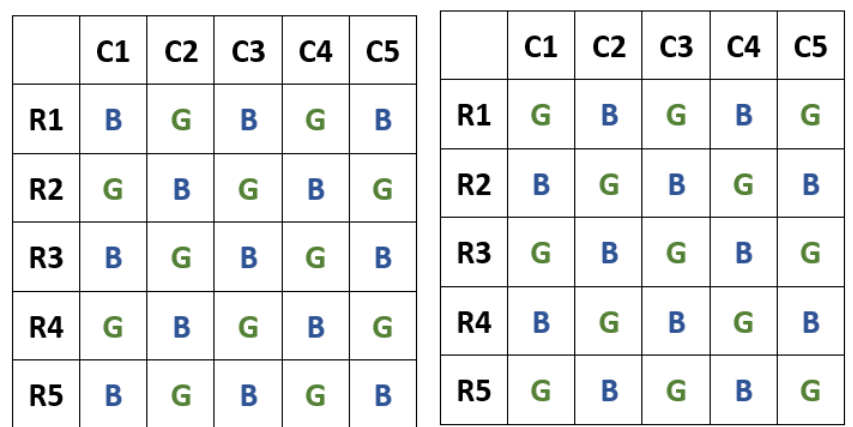
It is clear that using Red would require the other 2 colours too. Hence, combinations of Red +
Blue and Red + Green are not possible.
Using Blue + Green combination:
2 arrangements are possible
What is the maximum possible number of Red beads that can appear in any conguration?
Video Explanation

Explanatory Answer
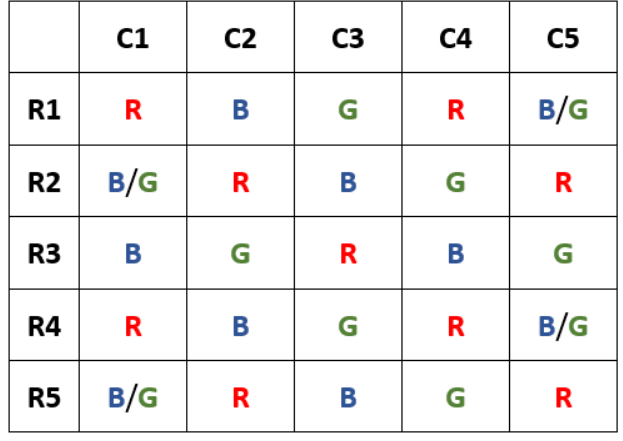
Maximum number of Red beads possible in a configuration = 9
What is the minimum number of Blue beads in any conguration?
Video Explanation

Explanatory Answer
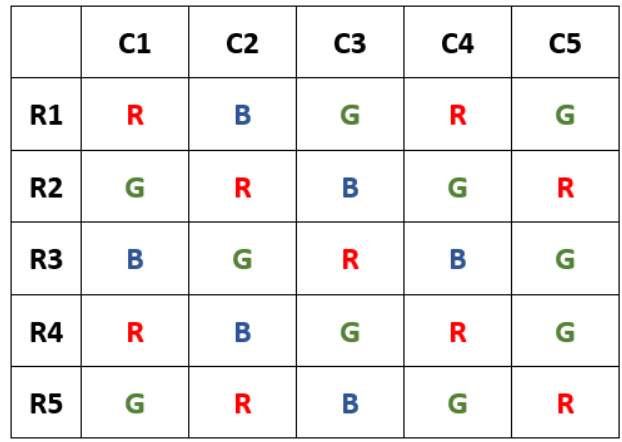
Minimum number of Blue beads possible in a configuration = 6
Two Red beads have been placed in ‘second row, third column’ and ‘third row, second column’. How many more Red beads can be placed so as to maximise the number of Red beads used in the configuration?
Video Explanation

Explanatory Answer
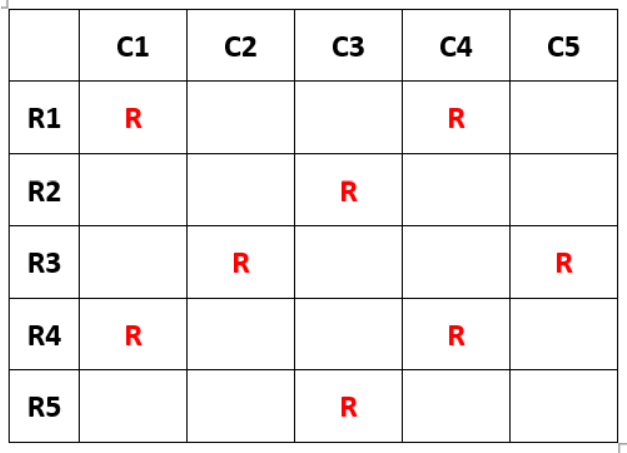
If we place 2 red beads at R2-C3 and R3-C2, the rest of the red beads can be maximised in the
following way:
A total of 8 red beads can be placed in this configuration. Hence, we can place 6 more red
beads to maximise their number.
A shopping mall has a large basement parking lot with parking slots painted in it along a single row. These slots are quite narrow; a compact car can fit in a single slot but an SUV requires two slots. When a car arrives, the parking attendant guides the car to the first available slot from the beginning of the row into which the car can fit.
For our purpose, cars are numbered according to the order in which they arrive at the lot. For example, the first car to arrive is given a number 1, the second a number 2, and so on. This numbering does not indicate whether a car is a compact or an SUV. The configuration of a parking lot is a sequence of the car numbers in each slot. Each single vacant slot is represented by letter V.
For instance, suppose cars numbered 1 through 5 arrive and park, where cars 1, 3 and 5 are compact cars and 2 and 4 are SUVs. At this point, the parking lot would be described by the sequence 1, 2, 3, 4, 5. If cars 2 and 5 now vacate their slots, the parking lot would now be described as 1, V, V, 3, 4. If a compact car (numbered 6) arrives subsequently followed by an SUV (numbered 7), the parking lot would be described by the sequence 1, 6, V, 3, 4, 7.
Answer the following questions INDEPENDENTLY of each other.
Initially cars numbered 1, 2, 3, and 4 arrive among which 1 and 4 are SUVs while 2 and 3 are compact cars. Car 1 then leaves, followed by the arrivals of car 5 (a compact car) and car 6 (an SUV). Car 4 then leaves. Then car 7 (an SUV) and car 8 (a compact car) arrive. At this moment, which among the following numbered car is parked next to car 3?
Video Explanation

Explanatory Answer

Hence, cars 7 & 2 are parked near car 3.
Suppose eight cars have arrived, of which two have left. Also suppose that car 4 is a compact and car 7 is an SUV. Which of the following is a POSSIBLE current configuration of the parking lot?
Video Explanation

Explanatory Answer
From the options, we can understand that initially, cars 1-6 were in the lot, post which 1 & 4 left
and 7 & 8 came in.
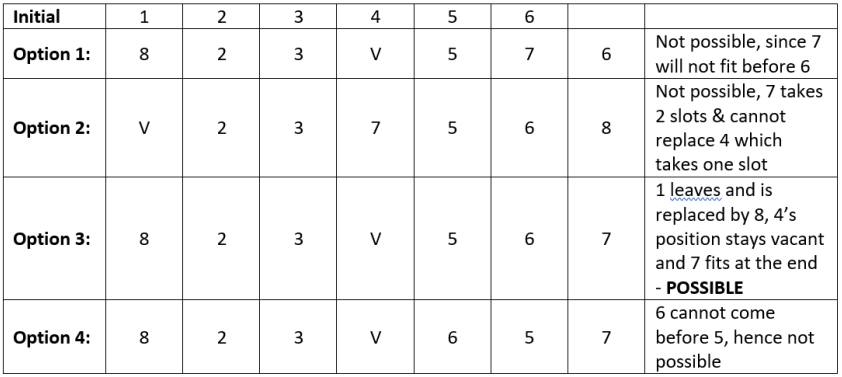
Suppose the sequence at some point of time is 4, 5, 6, V, 3. Which of the following is NOT necessarily true?
Video Explanation

Explanatory Answer
4, 6, 5, V, 3
• This tells us that 1 & 2 have left and 4, 5, and 6 have joined after 3 entered and 1 & 2 left.
• Also, this implies that 1 & 2 leaving has accommodated 4 positions: 4, 5, 6, & V.
• Therefore, 1 & 2 must be SUVs, and 4, 5, & 6 must be compacts. Nothing can be concluded about
Car 3.
Suppose that car 4 is not the first car to leave and that the sequence at a time between the arrival of the car 7 and car 8 is V, 7, 3, 6, 5. Then which of the following statements MUST be false?
Video Explanation

Explanatory Answer
V, 7, 3, 6, 5
Initial sequence could be 1, 2, 3, 4, 5
Now, we know that 4 was not the first car to leave. However, 6 is the next car and is taking the
position of 4.
The possibilities could be:
• 1 leaves , followed by 4, OR
• 2 leaves, followed by 4
In either case, the positions after both cars leaving would be 1, V, 3, V, 5 or V, 2, 3, V, 5.
Now, 6 arrives and takes the position of 4, skipping the initial vacant position in both cases. This
is only possible when the first vacant position is not enough to accommodate Car 6. Hence, Car
6 must be an SUV.
A chain of departmental stores has outlets in Delhi, Mumbai, Bengaluru and Kolkata. The sales are categorized by its three departments – ‘Apparel’, ‘Electronics’, and ‘HomeDecor’. An Accountant has been asked to prepare a summary of the 2018 and 2019 sales amounts for an internal report. He has collated partial information and prepared the following table.
The following additional information is known.
1. The sales amounts in the Apparel departments were the same for Delhi and Kolkata in 2018.
2. The sales amounts in the Apparel departments were the same for Mumbai and Bengaluru in 2018. This sales amount matched the sales amount in the Apparel department for Delhi in 2019.
3. The sales amounts in the HomeDecor departments were the same for Mumbai and Kolkata in 2018.
4. The sum of the sales amounts of four Electronics departments increased by the same amount as the sum of the sales amounts of four Apparel departments from 2018 to 2019.
5. The total sales amounts of the four HomeDecor departments increased by Rs 70 Crores from 2018 to 2019.
6. The sales amounts in the HomeDecor departments of Delhi and Bengaluru each increased by Rs 20 Crores from 2018 to 2019.
7. The sales amounts in the Apparel departments of Delhi and Bengaluru each increased by the same amount in 2019 from 2018. The sales amounts in the Apparel departments of Mumbai and Kolkata also each increased by the same amount in 2019 from 2018.
8. The sales amounts in the Apparel departments of Delhi, Kolkata and Bengaluru in 2019 followed an Arithmetic Progression.
In HomeDecor departments of which cities were the sales amounts the highest in 2018 and 2019, respectively?
Video Explanation

Explanatory Answer

From (4),
Increase in Electronics sales from 2018 to 2019:
(98+102+70+100) – (78+82+90+80) = 4 0 = Increase in Apparels sales from 2018 to 2019
• From (5),
Total sales in Home Décor in 2019 = 100+72+80+54 = 306
Hence, Total sales in Home Décor in 2018 = 306 – 70 = 236
From (6), we know sales of Home Décor in 2018 of Delhi and Bangalore.
80 + Z + 60 + Z = 236
2Z = 96
Z = 48
• From (7), we know that
Y – X = B – Y
2Y = B + X
B = 2Y – X -----------( i )
Also,
A – Y = 54 – X ---------(ii)
• F rom (8), we know that Y , 54, and B are in A.P.
54 – Y = B – 54
B = 108 – Y ----------(iii)
Therefore, from ( i ) we get
108 – Y = 2Y – X
X = 3Y – 108 ------------(iv)
And (ii) becomes:
A – Y = 54 – (3Y – 108)
A = 54 – 3Y + 108 + Y
A = 162 – 2Y ----------(v)
• From (4), we knew that
( Y +A+B+54) – (X+ Y+Y +X) = 4 0
Substituting values from (iii), (iv), and (v), we get:
(Y+162-2Y+108-Y+54) – (3Y-108 +Y+Y+3Y-108) = 40
324 – 2Y – 8Y + 216 = 40
10Y = 500
Y = 50
Therefore, we get values of A, B, and X by substituting values of Y.
A = 162 – 2Y = 162 – 100
A = 62
B = 108 – y = 108 – 50
B = 58
X = 3Y – 108 = 150 – 108
X = 42
Therefore, our final table looks like this:

We can see form the table that Delhi had the highest sales amount in Home Décor in both the
years.
What was the increase in sales amount, in Crore Rupees, in the Apparel department of Mumbai from 2018 to 2019?
Video Explanation

Explanatory Answer

From (4),
Increase in Electronics sales from 2018 to 2019:
(98+102+70+100) – (78+82+90+80) = 4 0 = Increase in Apparels sales from 2018 to 2019
• From (5),
Total sales in Home Décor in 2019 = 100+72+80+54 = 306
Hence, Total sales in Home Décor in 2018 = 306 – 70 = 236
From (6), we know sales of Home Décor in 2018 of Delhi and Bangalore.
80 + Z + 60 + Z = 236
2Z = 96
Z = 48
• From (7), we know that
Y – X = B – Y
2Y = B + X
B = 2Y – X -----------( i )
Also,
A – Y = 54 – X ---------(ii)
• F rom (8), we know that Y , 54, and B are in A.P.
54 – Y = B – 54
B = 108 – Y ----------(iii)
Therefore, from ( i ) we get
108 – Y = 2Y – X
X = 3Y – 108 ------------(iv)
And (ii) becomes:
A – Y = 54 – (3Y – 108)
A = 54 – 3Y + 108 + Y
A = 162 – 2Y ----------(v)
• From (4), we knew that
( Y +A+B+54) – (X+ Y+Y +X) = 4 0
Substituting values from (iii), (iv), and (v), we get:
(Y+162-2Y+108-Y+54) – (3Y-108 +Y+Y+3Y-108) = 40
324 – 2Y – 8Y + 216 = 40
10Y = 500
Y = 50
Therefore, we get values of A, B, and X by substituting values of Y.
A = 162 – 2Y = 162 – 100
A = 62
B = 108 – y = 108 – 50
B = 58
X = 3Y – 108 = 150 – 108
X = 42
Therefore, our final table looks like this:

Mumbai’s sales in Apparel department increased by 12 crores (62cr – 50cr)
Among all the 12 departments (i.e., the 3 departments in each of the 4 cities), what was the maximum percentage increase in sales amount from 2018 to 2019?
Video Explanation

Explanatory Answer

From (4),
Increase in Electronics sales from 2018 to 2019:
(98+102+70+100) – (78+82+90+80) = 4 0 = Increase in Apparels sales from 2018 to 2019
• From (5),
Total sales in Home Décor in 2019 = 100+72+80+54 = 306
Hence, Total sales in Home Décor in 2018 = 306 – 70 = 236
From (6), we know sales of Home Décor in 2018 of Delhi and Bangalore.
80 + Z + 60 + Z = 236
2Z = 96
Z = 48
• From (7), we know that
Y – X = B – Y
2Y = B + X
B = 2Y – X -----------( i )
Also,
A – Y = 54 – X ---------(ii)
• F rom (8), we know that Y , 54, and B are in A.P.
54 – Y = B – 54
B = 108 – Y ----------(iii)
Therefore, from ( i ) we get
108 – Y = 2Y – X
X = 3Y – 108 ------------(iv)
And (ii) becomes:
A – Y = 54 – (3Y – 108)
A = 54 – 3Y + 108 + Y
A = 162 – 2Y ----------(v)
• From (4), we knew that
( Y +A+B+54) – (X+ Y+Y +X) = 4 0
Substituting values from (iii), (iv), and (v), we get:
(Y+162-2Y+108-Y+54) – (3Y-108 +Y+Y+3Y-108) = 40
324 – 2Y – 8Y + 216 = 40
10Y = 500
Y = 50
Therefore, we get values of A, B, and X by substituting values of Y.
A = 162 – 2Y = 162 – 100
A = 62
B = 108 – y = 108 – 50
B = 58
X = 3Y – 108 = 150 – 108
X = 42
Therefore, our final table looks like this:

We see maximum percentage increase in the Home Décor department in Mumbai, increasing from
48 to 72.
Increase = [(72-48)/ 48]* 100 = 50%
What was the total sales amount, in Crore Rupees, in 2019 for the chain of departmental stores?
Video Explanation

Explanatory Answer

From (4),
Increase in Electronics sales from 2018 to 2019:
(98+102+70+100) – (78+82+90+80) = 4 0 = Increase in Apparels sales from 2018 to 2019
• From (5),
Total sales in Home Décor in 2019 = 100+72+80+54 = 306
Hence, Total sales in Home Décor in 2018 = 306 – 70 = 236
From (6), we know sales of Home Décor in 2018 of Delhi and Bangalore.
80 + Z + 60 + Z = 236
2Z = 96
Z = 48
• From (7), we know that
Y – X = B – Y
2Y = B + X
B = 2Y – X -----------( i )
Also,
A – Y = 54 – X ---------(ii)
• F rom (8), we know that Y , 54, and B are in A.P.
54 – Y = B – 54
B = 108 – Y ----------(iii)
Therefore, from ( i ) we get
108 – Y = 2Y – X
X = 3Y – 108 ------------(iv)
And (ii) becomes:
A – Y = 54 – (3Y – 108)
A = 54 – 3Y + 108 + Y
A = 162 – 2Y ----------(v)
• From (4), we knew that
( Y +A+B+54) – (X+ Y+Y +X) = 4 0
Substituting values from (iii), (iv), and (v), we get:
(Y+162-2Y+108-Y+54) – (3Y-108 +Y+Y+3Y-108) = 40
324 – 2Y – 8Y + 216 = 40
10Y = 500
Y = 50
Therefore, we get values of A, B, and X by substituting values of Y.
A = 162 – 2Y = 162 – 100
A = 62
B = 108 – y = 108 – 50
B = 58
X = 3Y – 108 = 150 – 108
X = 42
Therefore, our final table looks like this:

Total sales amount in 2019:
(50 + 62 + 58 + 54) + (98 + 102 + 70 + 100) + (100 + 72 + 80 + 54)
= (224) + (370) + (306)
= 900 crores
In an election several candidates contested for a constituency. In any constituency, the winning candidate was the one who polled the highest number of votes, the first runner up was the one who polled the second highest number of votes, the second runner up was the one who polled the third highest number of votes, and so on. There were no ties (in terms of number of votes polled by the candidates) in any of the constituencies in this election.
In an electoral system, a security deposit is the sum of money that a candidate is required to pay to the election commission before he or she is permitted to contest. Only the defeated candidates (i.e., one who is not the winning candidate) who fail to secure more than one sixth of the valid votes polled in the constituency, lose their security deposits.
The following table provides some incomplete information about votes polled in four constituencies: A, B, C and D, in this election.

The following additional facts are known:
1. The first runner up polled 10,000 more votes than the second runner up in constituency A. 2. None of the candidates who contested in constituency C lost their security deposit. The difference in votes polled by any pair of candidates in this constituency was at least 10,000.
3. The winning candidate in constituency D polled 5% of valid votes more than that of the first runner up. All the candidates who lost their security deposits while contesting for this constituency, put together, polled 35% of the valid votes.
What is the percentage of votes polled in total by all the candidates who lost their security deposits while contesting for constituency A?
Video Explanation

Explanatory Answer
We know that candidates who failed to secure more 1/6 th of total valid votes lose their
security deposit.
Let us put the information we have in a table:
• From (1), we know that the 2 nd runner-up in A polled 95000-10000 = 85000 votes
• From (2), we know that everyone in C secured more than (1/ 6)* 600030 = 100005 votes . Also,
the minimum difference between any 2 candidates’ votes was 10,000.
• From (3), let’s assume the total no. of votes polled in D was 100x. Then votes polled by winner =
37,500 + 5x.
Also, we know that candidates who lost their deposit in D together polled 35% votes .

Total votes polled in A = 5,00,000
Total votes polled by top 3 candidates = 2,75,000 + 95,000 + 85,000 = 4,55,000
Votes polled by bottom 7 candidates = 5,00,000 – 4,55,000 = 45,000
We can see that 45,000 is clearly less than 1/6 th of 5,00,000 (83,333) . Hence, all the bottom 7
candidates lost their deposit.
Total % votes polled by them = \(({45000 \over {500000}})*100\) = 9%
How many candidates who contested in constituency B lost their security deposit?
Video Explanation

Explanatory Answer
We know that candidates who failed to secure more 1/6 th of total valid votes lose their
security deposit.
Let us put the information we have in a table:
• From (1), we know that the 2 nd runner-up in A polled 95000-10000 = 85000 votes
• From (2), we know that everyone in C secured more than (1/ 6)* 600030 = 100005 votes . Also,
the minimum difference between any 2 candidates’ votes was 10,000.
• From (3), let’s assume the total no. of votes polled in D was 100x. Then votes polled by winner =
37,500 + 5x.
Also, we know that candidates who lost their deposit in D together polled 35% votes .

Total votes polled in B = 3,25,000
1/6 th of 325000 = 54166.66 ̴ 54167
We can see that the winning candidate also secured less than 1/6 th of the total valid votes.
Hence, the rest 11 candidates must have secured lesser votes than that.
Hence, 11 candidates lost their security deposit in B.
What BEST can be concluded about the number of votes polled by the winning candidate in constituency C?
Video Explanation

Explanatory Answer
We know that candidates who failed to secure more 1/6 th of total valid votes lose their
security deposit.
Let us put the information we have in a table:
• From (1), we know that the 2 nd runner-up in A polled 95000-10000 = 85000 votes
• From (2), we know that everyone in C secured more than (1/ 6)* 600030 = 100005 votes . Also,
the minimum difference between any 2 candidates’ votes was 10,000.
• From (3), let’s assume the total no. of votes polled in D was 100x. Then votes polled by winner =
37,500 + 5x.
Also, we know that candidates who lost their deposit in D together polled 35% votes .

Total no. of votes polled in C = 6,00,030
Total no. of candidates = 5
We know that everyone polled more than 1,00,005 votes in C, and minimum diff between any 2 is
10,000.
Hence, minimum votes polled by bottom 4 :
( 1,00,006 ) + ( 1,00, 006 + 10 000) + (1,00,006 + 2*10000) + (1,00,006 + 3*10000)
= 4*1,00,006 + 60,000 = 4,60,024 votes
Maximum votes polled by winning candidate = 6,00,030 – 4,60,024 = 1,40,006
Minimum votes polled by 1 st runner-up = 1,00,006 + 30,000 = 1,30,006
Diff between the two is 10,000. Hence, we can conclude that winner polled exactly 1,40,006
votes.
What was the number of valid votes polled in constituency D?
Video Explanation

Explanatory Answer
We know that candidates who failed to secure more 1/6 th of total valid votes lose their
security deposit.
Let us put the information we have in a table:
• From (1), we know that the 2 nd runner-up in A polled 95000-10000 = 85000 votes
• From (2), we know that everyone in C secured more than (1/ 6)* 600030 = 100005 votes . Also,
the minimum difference between any 2 candidates’ votes was 10,000.
• From (3), let’s assume the total no. of votes polled in D was 100x. Then votes polled by winner =
37,500 + 5x.
Also, we know that candidates who lost their deposit in D together polled 35% votes .

Total votes polled in D = 100x
Votes secured by top 4 = 37,500 + 5x + 37,500 + 30,000 + 10x = 1,05,000 + 15x
We can also see that the 3 rd runner-up secured less than 1/6 th (10%) votes and hence lost
security deposit. So, minimum 5 and maximum 7 candidates lost security deposit.
We can have 3 cases here:
CASE I: 7 candidates (all except winner) lost security deposit. In this case, top candidate will
have remining 65% votes.
37,500 + 5x = 65x
60x = 37,500
x = 625
Total votes polled = 100x = 62 , 500
1/6 th of 62,500 = 10,417
Votes secured by 1 st runner-up = 37,500 > 10,417
1 st runner up couldn’t have lost deposit. Hence, this case is not feasible.
CASE II: 6 candidates (all except winner & 1 st runner-up) lost security deposit. In this case, top 2
candidates will have remining 65% votes.
37,500 + 5x + 37,500 = 65x
75,000 = 60x
x = 1250
Total votes polled = 100x = 1,25,000
1/6 th of 1,25,000 = 20,833
Once again, 1 st runner-up secured more than 1/6 th votes and couldn’t have lost deposit. This
case is also not feasible.
CASE III: 5 candidates (all except winner, 1 st runner-up & 2 nd runner-up) lost security deposit.
In this case, top 3 candidates will have remining 65% votes.
75,000 + 5x + 30,000 = 65x
60x = 1,05,000
x = 17 50
Total votes polled = 100x = 1,75,000
1/6 th of 1,75,000 = 29,167
Votes secured by 3 rd runner-up = 10x = 10,500 < 29,167
Hence, this is the only feasible case.
Therefore, total number of valid votes polled in D is 1,75,000.
The winning margin of a constituency is defined as the difference of votes polled by the winner and that of the first runner up. Which of the following CANNOT be the list of constituencies, in increasing order of winning margin?
Video Explanation

Explanatory Answer

The confirmed order we know is D < C < A. ‘B’ could be anywhere in between except more than
A.
Hence, B < C < D < A is not possible as we know that margin of C is greater than that of D.
For all the four constituencies taken together, what was the approximate number of votes polled by all the candidates who lost their security deposit expressed as a percentage of the total valid votes from these four constituencies?
Video Explanation

Explanatory Answer
Total number of valid votes in 4 constituencies = 5,00,000 + 3,25,000 + 6,00,030 + 1,75,000
= 16,00,030
We can consolidate the data about the candidates who lost security in the below table:
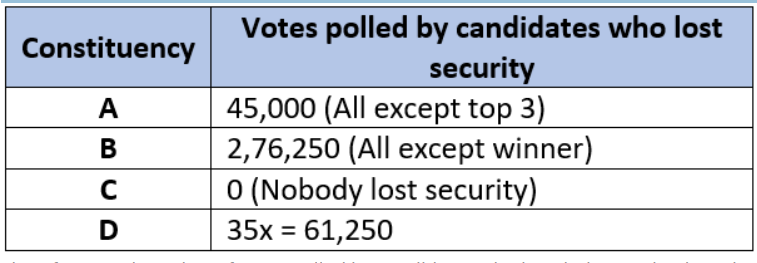
Therefore, total number of votes polled by candidates who lost their security deposit:
45,000 + 2,76,250 + 0 + 61,250 = 3,82,500
% = (3,82,500/16,00, 030)* 100 = 23.9%
The Humanities department of a college is planning to organize eight seminars, one for each of the eight doctoral students - A, B, C, D, E, F, G and H. Four of them are from Economics, three from Sociology and one from Anthropology department. Each student is guided by one among P, Q, R, S and T. Two students are guided by each of P, R and T, while one student is guided by each of Q and S. Each student is guided by a guide belonging to their department.
Each seminar is to be scheduled in one of four consecutive 30-minute slots starting at 9:00 am, 9:30 am, 10:00 am and 10:30 am on the same day. More than one seminars can be scheduled in a slot, provided the guide is free. Only three rooms are available and hence at the most three seminars can be scheduled in a slot. Students who are guided by the same guide must be scheduled in consecutive slots.
The following additional facts are also known.
1. Seminars by students from Economics are scheduled in each of the four slots.
2. A’s is the only seminar that is scheduled at 10:00 am. A is guided by R.
3. F is an Anthropology student whose seminar is scheduled at 10:30 am.
4. The seminar of a Sociology student is scheduled at 9:00 am.
5. B and G are both Sociology students, whose seminars are scheduled in the same slot. The seminar of an Economics student, who is guided by T, is also scheduled in the same slot.
6. P, who is guiding both B and C, has students scheduled in the first two slots.
7. A and G are scheduled in two consecutive slots.
Which one of the following statements is true?
Video Explanation

Explanatory Answer
Let’s start by consolidating all information available:
• We know we have 4 Economics, 3 Sociology, and 1 Anthropology student.
• 5 guides: P, R, and T guide 2 students each. Q and S guide one student each.
• Each student has guide belonging to same department.
• 4 slots: 9am, 9.30am, 10am, and 10.30am. Maximum 3 seminars in each slot.
Seminars guided by same person never in same slot, always in consecutive slots.
Let’s create a table and fill all further information in it:
• From (1), Economics students have seminars in all 4 slots
• From (2), 10am has only one seminar by ‘A’, hence A must be Economics student
• From (3), 10.30 has another seminar of Anthropology. ‘F’ must be the only Anthropology student.
From (4), 9am has another seminar of Sociology.
• From (5), B & G have seminars in same slot. This slot cannot be either of the last 2 slots, since we
need 2 empty slots. Hence, B & G are scheduled at either 9am or 9.30 am.
• From (6), since P is guiding B & C, C must be a Sociology student too, and B & C must have
seminars in consecutive slots. Hence, C must be 9/9.30 depending on B’s slot.
• From (7), since A’s slot is 10, G (along with B) must be scheduled at 9.30am. Consequently, C
must be scheduled at 9am.
• We know identities of 3 Sociology and 1 Anthropology student, hence remaining must be
Economics students.
• Since Q & S guide 1 student each, they must be either of Anthropology or Sociology guides, and
must guide either of F or G. Hence, R & T are Economics guides.
• Since same guides must have consecutive slots, R must have 10 and 10.30 slots while T has 9 &
9.30 slots.
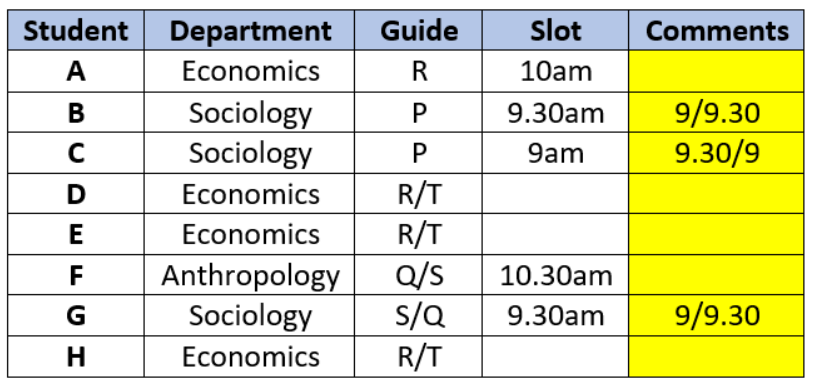
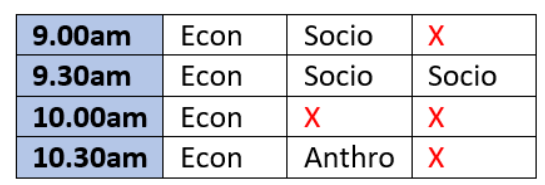
A is clear from the solution, the first slot has 2 seminars.
Who all are NOT guiding any Economics students?
Video Explanation

Explanatory Answer
Let’s start by consolidating all information available:
• We know we have 4 Economics, 3 Sociology, and 1 Anthropology student.
• 5 guides: P, R, and T guide 2 students each. Q and S guide one student each.
• Each student has guide belonging to same department.
• 4 slots: 9am, 9.30am, 10am, and 10.30am. Maximum 3 seminars in each slot.
Seminars guided by same person never in same slot, always in consecutive slots.
Let’s create a table and fill all further information in it:
• From (1), Economics students have seminars in all 4 slots
• From (2), 10am has only one seminar by ‘A’, hence A must be Economics student
• From (3), 10.30 has another seminar of Anthropology. ‘F’ must be the only Anthropology student.
From (4), 9am has another seminar of Sociology.
• From (5), B & G have seminars in same slot. This slot cannot be either of the last 2 slots, since we
need 2 empty slots. Hence, B & G are scheduled at either 9am or 9.30 am.
• From (6), since P is guiding B & C, C must be a Sociology student too, and B & C must have
seminars in consecutive slots. Hence, C must be 9/9.30 depending on B’s slot.
• From (7), since A’s slot is 10, G (along with B) must be scheduled at 9.30am. Consequently, C
must be scheduled at 9am.
• We know identities of 3 Sociology and 1 Anthropology student, hence remaining must be
Economics students.
• Since Q & S guide 1 student each, they must be either of Anthropology or Sociology guides, and
must guide either of F or G. Hence, R & T are Economics guides.
• Since same guides must have consecutive slots, R must have 10 and 10.30 slots while T has 9 &
9.30 slots.


R & T are guiding Economics students while P, Q, and S are not.
Which of the following statements is necessarily true?
Video Explanation

Explanatory Answer
Let’s start by consolidating all information available:
• We know we have 4 Economics, 3 Sociology, and 1 Anthropology student.
• 5 guides: P, R, and T guide 2 students each. Q and S guide one student each.
• Each student has guide belonging to same department.
• 4 slots: 9am, 9.30am, 10am, and 10.30am. Maximum 3 seminars in each slot.
Seminars guided by same person never in same slot, always in consecutive slots.
Let’s create a table and fill all further information in it:
• From (1), Economics students have seminars in all 4 slots
• From (2), 10am has only one seminar by ‘A’, hence A must be Economics student
• From (3), 10.30 has another seminar of Anthropology. ‘F’ must be the only Anthropology student.
From (4), 9am has another seminar of Sociology.
• From (5), B & G have seminars in same slot. This slot cannot be either of the last 2 slots, since we
need 2 empty slots. Hence, B & G are scheduled at either 9am or 9.30 am.
• From (6), since P is guiding B & C, C must be a Sociology student too, and B & C must have
seminars in consecutive slots. Hence, C must be 9/9.30 depending on B’s slot.
• From (7), since A’s slot is 10, G (along with B) must be scheduled at 9.30am. Consequently, C
must be scheduled at 9am.
• We know identities of 3 Sociology and 1 Anthropology student, hence remaining must be
Economics students.
• Since Q & S guide 1 student each, they must be either of Anthropology or Sociology guides, and
must guide either of F or G. Hence, R & T are Economics guides.
• Since same guides must have consecutive slots, R must have 10 and 10.30 slots while T has 9 &
9.30 slots.


• S may be guiding either of ‘F’ or ‘G’, so not necessarily true
• Similarly, Q may be guiding either of ‘F’ or ‘G’, so not necessarily true
• We are sure that ‘H’ is an Economics student, hence TRUE
• ‘B’ is scheduled in the second slot, hence False
If D is scheduled in a slot later than Q's, then which of the following two statement(s) is(are) true?
(i) E and H are guided by T.
(ii) G is guided by Q.
Video Explanation

Explanatory Answer
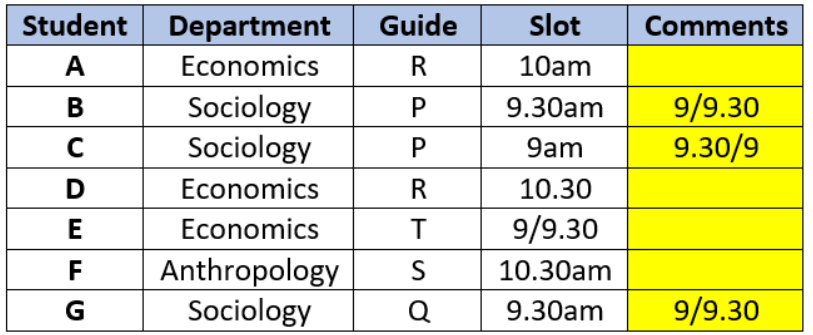
• If ‘D’ is scheduled in a slot later than Q’s, it means that Q must be in the 9.30am slot, guiding ‘G’.
Hence, S is in the 10.30am slot guiding ‘F’.
• Also, it implies that ‘D’ must be scheduled in the 10.30 slot guided by R, and ‘E’ & ‘H’ are in the
9am or 9.30am slot guided by T.
Hence, both statements are true.
If E and Q are both scheduled in the same slot, then which of the following statements BEST describes the relationship between D, H, and T?
Video Explanation

Explanatory Answer
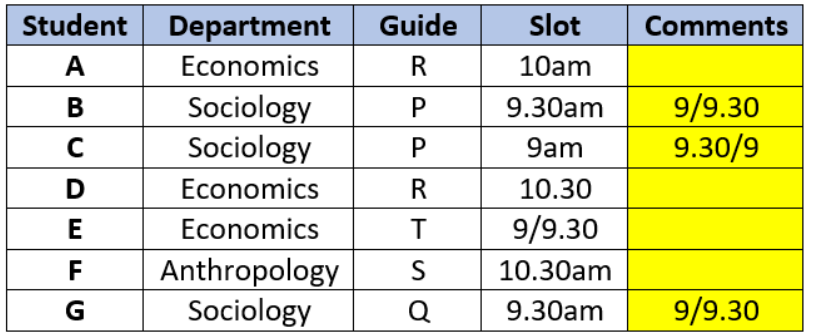
• If Q is scheduled in the 9.30am slot guiding ‘G’, ‘E’ must also be in 9.30am slot guided by T.
• If Q is scheduled in the 10.30am slot guiding ‘F’, ‘E’ must also be in 10.30am slot guided by R.
Hence, no new inferences can be gained from this information.
Since ‘A’ is guided by R, at least one of ‘D’ and ‘H’ will have to be guided by T.
If D is scheduled in the slot immediately before Q’s, then which of the following is NOT necessarily true?
Video Explanation

Explanatory Answer
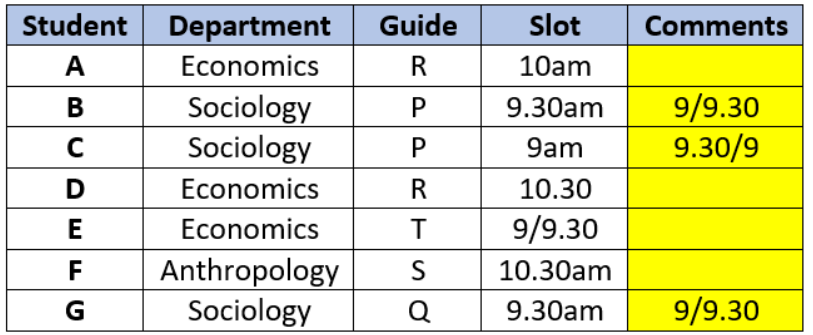
If Q is in 10.30am slot, ‘D’ must be in 10am slot. But that is not feasible as A is in the 10am slot
already and no 2 Eco students are in the same slot.
Hence, Q must be in the 9.30am slot and ‘D’ in the 9am slot guided by T. We can see from the
solution that ‘E’ may be guided by either R or T.
In a car race, car A beats car B by 45 km, car B beats car C by 50 km, and car A beats car C by 90 km. The distance (in km) over which the race has been conducted is
Video Explanation

Explanatory Answer
Answer - A
Let the length of track be ‘x’
In time ‘ t A ’, distances covered by all 3 cars are:
A: x (completes race)
B: x - 45
C: x – 90
In time ‘ t B ’, distances covered are:
B: x (Completes race)
C: x – 50
Ratio of distances = ratio of speeds
Therefore, ratio of speeds of B & C are:
\({x-45 \over {x-90}}={x \over {x-50}}\)
\((x-45)(x-50)=x(x-90)\)
\(x^{2}-95x+2250=x^{2}-90x\)
\(5x=2250\)
\(x=450\)
From the interior point of an equilateral triangle, perpendiculars are drawn on all three sides. The sum of the lengths of the perpendiculars is 's'. Then the area of the triangle is
Video Explanation

Explanatory Answer
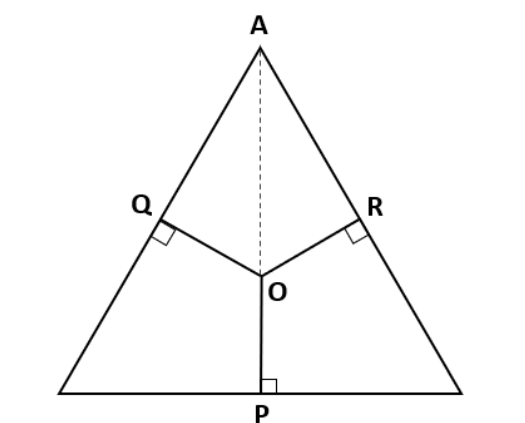
Let OP, OQ, and OR be 3 altitudes drawn from the centroid of the
equilateral triangle.
Length of all 3 p erpendicular s will be equal . Therefore, length of
OP = OQ = OR = s/3
AP is the altitude of the triangle. We know that the centroid divides
the altitude in the ratio 2:1
Hence, AO : OP = 2:1
AO = 2s/3
AP = AO + OP = s
Let side of triangle be ‘a’
Altitude AP = s = Ö 3a/2
a = 2s/ Ö 3
Area of triangle = (½)*a*s
= (½)*2s/ Ö 3*s
= s 2 / Ö 3
In a group of 10 students, the mean of the lowest 9 scores is 42 while the mean of the highest 9 scores is 47. For the entire group of 10 students, the maximum possible mean exceeds the minimum possible mean by
Video Explanation

Explanatory Answer
Let a1, a2, a3, … , a10 be the 10 scores in ascending order (a1 – lowest, a10 – highest)
Mean of lowest 9 scores = 42
Sum of lowest 9 scores = 42*9 = 378 = a1+a2+ ….+ a9
Mean of highest 9 scores = 47
Sum of highest 9 scores = 47*9 = 423 = a2+a3+…+a10
Difference between highest and lowest score = 423-378 = 45 = a10-a1
Maximum possible mean when a1 is maximum
Hence a1=42, a10 = 87
Maximum mean = (378+87)/10 = 46.5
Minimum possible mean when a10 is minimum
Hence, a10=47, a1=2
Minimum mean = (423+2)/10 = 42.5
Difference = 46.5-42.5 = 4
The number of pairs of integers(x,y) satisfying x ≥ y ≥ -20 and 2x + 5y = 99 is
Video Explanation

Explanatory Answer
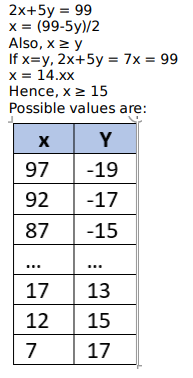

![]()
Video Explanation

Explanatory Answer
log a (a/b) + log b (b/a)
= log a a - log a b + log b b - log b a
= 1 - log a b + 1 - log b a
= 2 – ( log a b + log b a )
= 2 – ( logb / loga + loga / logb )
= 2 – (x+1/x) [ loga / logb = x]
Minimum possible value of (x+1/x) is 2 , given x is + ve and real.
Hence Maximum possible value of 2 – (x+1/x) = 0 and cannot be equal to 1
For the same principal amount, the compound interest for two years at 5% per annum exceeds the simple interest for three years at 3% per annum by Rs 1125. Then the principal amount in rupees is
Video Explanation

Explanatory Answer
Let Principal Amount = x
Compound Interest = \(x(1+0.05)^{2}-x\)
= \(x(1.05)^{2}-x\)
= \(1.1025x-x\)
= \(0.1025x\)
Simple Interest = \({x*3*3 \over {100}}\)
As stated in the question,
CI = SI + 1125
0.1025x = (9x/100) + 1125
1125 = 41x/400 – 9x/100 = 5x/400 = x/80
X = 90000
Let C be a circle of radius 5 meters having center at O. Let PQ be a chord of C that passes through points A and B where A is located 4 meters north of O and B is located 3 meters east of O. Then, the length of PQ, in meters, is nearest to
Video Explanation

Explanatory Answer
Since AOB is a right-angled triangle and AO = 4m, BO = 3m
AB = 5m
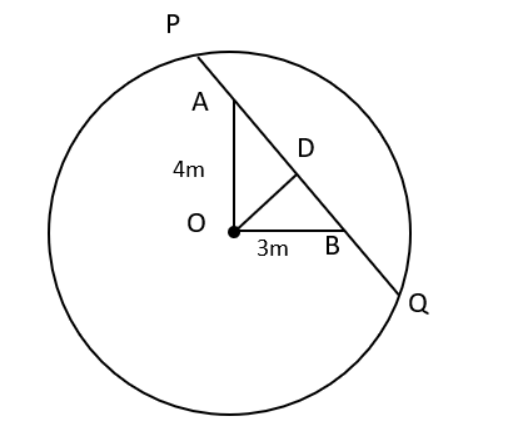
Dropping a perpendicular from O on AB at D, we know that:
OA * OB = AB * OD
4*3 = 5*OD
OD = 12/5
We know that OD bisects the chord PQ. Hence, PD = QD
Also, in triangle OPD:
OD 2 + PD 2 = OP 2
(12/5) 2 + PD 2 = 5 2 = 25
PD 2 = 25 – 144/25 = (625 – 144)/25 = 481/25
PD = Ö 481/5 ̴ 21.9/5 = 4.4
PQ = 2*PD = 8.8
Anil buys 12 toys and labels each with the same selling price. He sells 8 toys initially at 20% discount on the labeled price. Then he sells the remaining 4 toys at an additional 25% discount on the discounted price. Thus, he gets a total of Rs 2112, and makes a 10% profit. With no discounts, his percentage of profit would have been
Video Explanation

Explanatory Answer
Let common SP be x
For 8 toys, SP = 0.8x
For remaining 4 toys, SP = 0.75*0.8x = 0.6x
Total SP = 8* 0.8x + 4* 0.6x = 2112
6.4x + 2.4x = 2112
8.8x = 2112
x = 240
Also let Total Cost Price = y
2112 = 1.1y
y = 1920
With no discounts, Total SP = 12*240 = 2880
Profit = 2880-1920 = 960
Profit % = (960/ 1920)* 100 = 50%
If x and y are non-negative integers such that x + 9 = z, y + 1 = z and x + y < z + 5, then the maximum possible value of 2x + y equals
Video Explanation

Explanatory Answer
Acc. to the question:
x + 9 = z & y + 1 = z
Therefore, x + 9 = y + 1
y = x + 8
x + y < z + 5
x + x + 8 < x + 9 + 5
x < 6
Now, 2x + y = 2x + x + 8 = 3x + 8
For this to be maximum, x has to be maximum.
Maximum possible value of x = 5.
Therefore, max possible value of 3x + 8 = 3(5) + 8 = 23
Students in a college have to choose at least two subjects from chemistry, mathematics and physics. The number of students choosing all three subjects is 18, choosing mathematics as one of their subjects is 23 and choosing physics as one of their subjects is 25. The smallest possible number of students who could choose chemistry as one of their subjects is
Video Explanation

Explanatory Answer
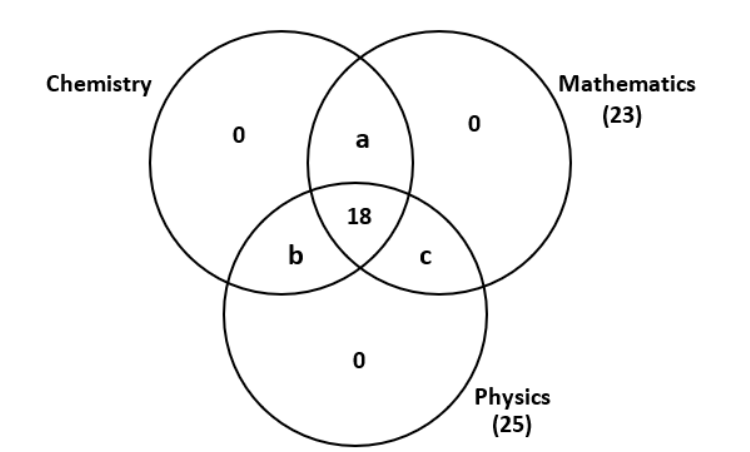
We can summarize the information given in the question as per the above Venn diagram.
We can conclude that:
a + c = 5
b + c = 7
Hence, b – a = 2
We have to minimize a + b.
Assuming if a = 0
Then b = 2 & c = 5
Therefore, number of students choosing Chemistry as one subject = 18 + 2 = 20
Let f(x) = x2 + ax + b and g(x) = f(x + 1) - f(x - 1). If f(x) ≥ 0 for all real x, and g(20) = 72, then the smallest possible value of b is
Video Explanation

Explanatory Answer
g( 20) = f(21) – f(19)
72 = 21 2 + 21a + b – (19 2 + 19a + b)
72 = 40*2 + 2a
2a = -8
a = -4
f(x) = x 2 - 4x + b
Now, f(x) ≥ 0 for all real x
Therefore, D ≤ 0
16 – 4b ≤ 0
16 ≤ 4b
4 ≤ b
Hence, smallest possible value of b is 4
The distance from B to C is thrice that from A to B. Two trains travel from A to C via B. The speed of train 2 is double that of train 1 while traveling from A to B and their speeds are interchanged while traveling from B to C. The ratio of the time taken by train 1 to that taken by train 2 in travelling from A to C is
Video Explanation

Explanatory Answer
BC = 3*AB
AB = x, BC = 3x
Let 2 trains be T1 & T2.
From A to B: Speed of T1 = s; Speed of T2 = 2s
From B to C: Speed of T1 = 2s; Speed of T2 = s
Total time taken by T1 (t1) = (x/ s)+( 3x/2s) = 5x/2s
Total time taken by T2 (t2) = (x/2s) + 3x/s) = 7x/2s
Ratio t1:t2 = 5x/2s:7x/2s = 5:7
The sum of perimeters of an equilateral triangle and a rectangle is 90 cm. The area, T, of the triangle and the area , R, of the rectangle, both in sq cm, satisfy the relationship R = T2. If the sides of the rectangle are in the ratio 1 : 3, then the length, in cm, of the longer side of the rectangle, is
Video Explanation

Explanatory Answer
Let side of triangle be ‘a’; Breadth of rectangle = x; Length of rectangle = 3x
Therefore: 3a + 2(x+3x) = 90
3a + 8x = 90 ----------( i )
Also, R = T 2
x *3x = ( Ö 3a 2 /4) 2
3x 2 = 3a 4 /16
x = a 2 /4
Hence ( i ) becomes:
3a + 8(a 2 /4) = 90
3a + 2a 2 = 90
2a 2 + 3a -90 = 0
Solving the quadratic equation, we get a = 6
x = 9 ; 3x = 27
Hence, longer side = 27
![]()
Video Explanation

Explanatory Answer
\((x^{2}-5x+7)^{(x+1)}=1\)
2 cases:
• Power is 0
x + 1 = 0
x = -1
• \(x^{2}-5x+7=1\)
\(x^{2}-5x+6=0\)
\(x^{2}-2x-3x+6=0\)
\(x(x-2)-3(x-2)=0\)
\((x-2)(x-3)=0\)
\(x=2, x=3\)
• \(x^{2}-5x+7=-1\) ; Given power is even
\(x^{2}-5x+8=0\)
No real roots
Hence, 3 integers (-1, 2, 3) satisfy the given equation
In how many ways can a pair of integers (x , a) be chosen such that x2 − 2 | x | + | a - 2 | = 0 ?
Video Explanation

Explanatory Answer
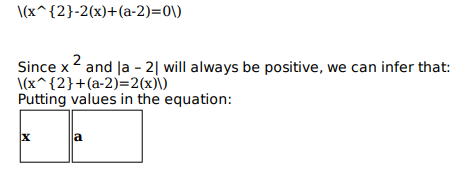
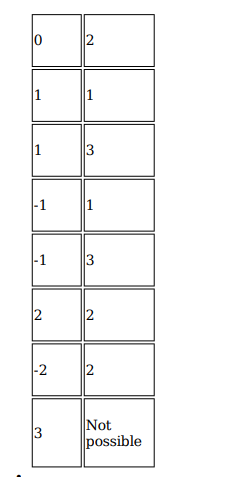
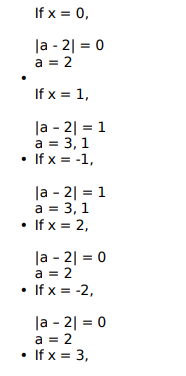

Two circular tracks T1 and T2 of radii 100 m and 20 m, respectively touch at a point A. Starting from A at the same time, Ram and Rahim are walking on track T1 and track T2 at speeds 15 km/hr and 5 km/hr respectively. The number of full rounds that Ram will make before he meets Rahim again for the first time is
Video Explanation

Explanatory Answer
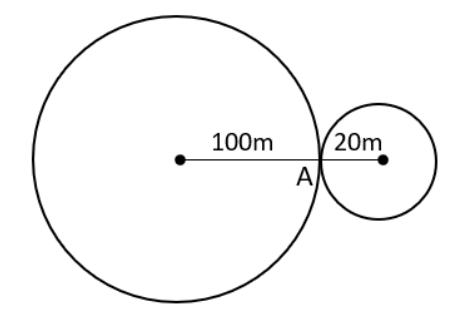
Circumference of T1 = 2π*100 = 200π
Time taken by Ram to reach A again = 200π/15 = 40π/3
Circumference of T2 = 2π*20 = 40π
Time taken by Rahim to reach A again = 40π/5
Ratio of the time taken by Ram & Rahim = (40π/3) /( 40 π/5) = 5/3
Ratio of time is inverse of ratio of distance travelled
Therefore, ratio of rounds travelled by Ram : Rahim = 3:5
Ram makes 3 rounds before he meets Rahim again
A and B are two points on a straight line. Ram runs from A to B while Rahim runs from B to A. After crossing each other, Ram and Rahim reach their destinations in one minutes and four minutes, respectively. If they start at the same time, then the ratio of Ram's speed to Rahim's speed is
Video Explanation

Explanatory Answer
![]()
Assuming Ram’s speed = ‘a’ and Rahim’s speed = ‘b’.
If they cross each other at time ‘t’:
Distance travelled by Ram = a*t
Distance travelled by Rahim = b*t
Further time taken by Ram to reach B = (Dist. Remaining/Speed) = (b*t)/a = 1min -------①
Similarly, further time taken by Rahim to reach A = (a*t)/b = 4min -------②
Assume ratio (a/b) = x
Therefore, ① becomes: t/x = 1 &
② becomes: t*x = 4
Multiplying both equations, we get: t 2 = 4
Therefore t = 2
Applying value of t, we get x = 2 = a/b
Let C1 and C2 be concentric circles such that the diameter of C1 is 2cm longer than that of C2. If a chord of C1 has length 6 cm and is a tangent to C2, then the diameter, in cm of C1 is
Video Explanation

Explanatory Answer
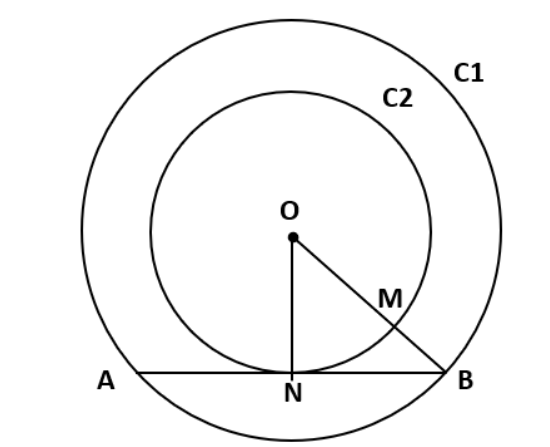
In the figure, ‘O’ is the centre of circles ‘C1’ and ‘C2’ with radii ‘ x ’ & ‘ y ’ respectively
If d1 – d2 = 2cm, x - y = 1cm
Hence, MB = 1cm
AB is a chord with 6cm length and tangent to C2.
Therefore, AN = NB = 3cm ; ON = y; OB = y + 1
In right triangle ONB:
(ON) 2 + (NB) 2 = (OB) 2
y 2 + 9 = (y+1) 2
9 = 2y + 1
2y + 8
y = 4
Therefore, x = y + 1 = 5cm
Diameter = 2x = 10cm
John takes twice as much time as Jack to finish a job. Jack and Jim together take one-thirds of the time to finish the job than John takes working alone. Moreover, in order to finish the job, John takes three days more than that taken by three of them working together. In how many days will Jim finish the job working alone?
Video Explanation

Explanatory Answer
Let’s assume the amount of work done by each person in a day:
John – x
Jack – 2x
If Jack and Jim together take 1/3 of the time that John takes, it means they together complete 3 times the work that John alone completes in a day.
Hence, Jack + Jim = 3x
Jim – x
Assuming the work to be done is 100 units.
Number of days taken by each person is:
John – 100/x
Jack – 50/x
Jim – 100/x
All 3 together – 25/x
Therefore, 100/x = 25/x + 3
100 = 25 + 3x
3x = 75
x = 25
Jim will finish the job alone in 100/x = 100/25 = 4 days
In May, John bought the same amount of rice and the same amount of wheat as he had bought in April, but spent 150 more due to price increase of rice and wheat by 20% and 12%, respectively. If John had spent 450 on rice in April, then how much did he spend on wheat in May?
Video Explanation

Explanatory Answer
In April, John bought ‘r’ amount of rice at ‘x’ price, and ‘w’ amount of wheat at ‘y’ price.
Money spent = r * x + w * y
Also, r*x = 450
In May, amount spent = r( 1.2x) + w(1.12y)
= 1.2r*x + 1.12w*y = (r*x + w*y) + 150
0.2r*x + 0.12w*y = 150
0.12w*y = 150 – 0.2*450 = 60
w*y = 60/0.12 = 500
Amount spent on wheat in May = 1.12*500 = 560
Aron bought some pencils and sharpeners. Spending the same amount of money as Aron, Aditya bought twice as many pencils and 10 less sharpeners. If the cost of one sharpener is 2 more than the cost of a pencil, then the minimum possible number of pencils bought by Aron and Aditya together is
Video Explanation

Explanatory Answer
Let cost of pencil be ‘x’ and sharpener be ‘x+2’.
Amount spent by Aron = p*x + s*(x+2)
Amount spent by Aditya = 2p*x + (s- 10)( x+2)
Therefore: px + sx + 2s = 2px + sx - 10x + 2s – 20
px - 10x - 20 = 0
x(p-10) = 20
Since p-10 > 0, p(min) = 11
Total pencils = p + 2p = 33
A sum of money is split among Amal, Sunil and Mita so that the ratio of the shares of Amal and Sunil is 3:2, while the ratio of the shares of Sunil and Mita is 4:5. If the difference between the largest and the smallest of these three shares is Rs 400, then Sunil’s share, in rupees, is
Video Explanation

Explanatory Answer
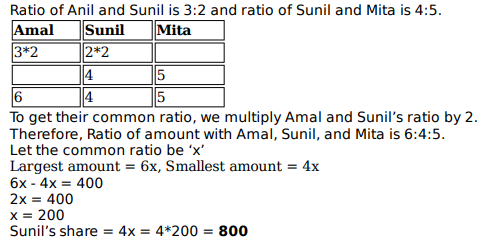
How many 4-digit numbers, each greater than 1000 and each having all four digits distinct, are there with 7 coming before 3?
Video Explanation

Explanatory Answer
3 cases:
• 7 is in first place: 3 can go to 3 places, remaining 2 places will have 8 & 7 possibilities each
Hence, possible numbers are 3*8*7 = 168
• 7 is in second place: 3 can go to 2 places, first place will have 7 possibilities (excluding 0), and
remaining place will also have 7 possibilities
Hence, possible numbers are 2*7*7 = 98
• 7 is in third place: 3 can only go to one place, remaining 2 places have 7 possibilities each
Hence, possible numbers are 1*7*7 = 49
Therefore, total number of possibilities are 168 + 98 + 49 = 315










